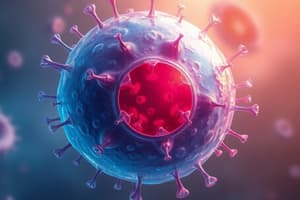Podcast
Questions and Answers
What is the primary difference between hypertrophy and hyperplasia?
What is the primary difference between hypertrophy and hyperplasia?
Hypertrophy refers to an increase in cell size, while hyperplasia involves an increase in the number of cells.
Describe a situation where metaplasia might occur and its significance.
Describe a situation where metaplasia might occur and its significance.
Metaplasia might occur in the respiratory epithelium of smokers, replacing normal cells with squamous cells, which can harm respiratory function.
Identify one cause of reversible cell injury and explain why it is reversible.
Identify one cause of reversible cell injury and explain why it is reversible.
Hypoxia can cause reversible cell injury as cells may recover once oxygen supply is restored.
What are the key distinctions between necrosis and apoptosis?
What are the key distinctions between necrosis and apoptosis?
Explain how nutritional imbalances can lead to cell injury.
Explain how nutritional imbalances can lead to cell injury.
What is a common outcome of irreversible cell injury?
What is a common outcome of irreversible cell injury?
How does ischemia relate to hypoxia in terms of cell injury?
How does ischemia relate to hypoxia in terms of cell injury?
Suggest an example of a chemical agent and its potential effect on cells.
Suggest an example of a chemical agent and its potential effect on cells.
Flashcards are hidden until you start studying
Study Notes
Cell Adaptation
- Definition: Changes in cell structure and function in response to stress or environmental changes.
- Types of Adaptation:
- Hypertrophy: Increase in cell size; often due to increased workload (e.g., cardiac hypertrophy).
- Hyperplasia: Increase in cell number; occurs in tissues capable of mitosis (e.g., glandular tissues).
- Atrophy: Decrease in cell size or number; results from decreased workload, nutrition, or blood supply (e.g., muscle atrophy).
- Metaplasia: Replacement of one cell type with another; often an adaptive response to chronic irritation (e.g., respiratory epithelium in smokers).
Cell Injury
-
Definition: Damage to cells that impairs function but may be reversible.
-
Causes of Cell Injury:
- Hypoxia: Reduced oxygen supply; can result from ischemia, anemia, or respiratory issues.
- Chemical Agents: Toxins, drugs, and pollutants can cause direct or indirect cellular damage.
- Infectious Agents: Bacteria, viruses, and parasites can invade and destroy cells.
- Physical Factors: Trauma, temperature extremes, and radiation can lead to cell injury.
- Nutritional Imbalances: Deficiencies or excesses can affect cellular functions.
-
Reversible vs Irreversible Injury:
- Reversible: Cell can recover if the stress is removed (e.g., mild hypoxia).
- Irreversible: Leads to cell death; characterized by severe mitochondrial damage, membrane rupture, and nuclear changes.
Cell Death
-
Mechanisms of Cell Death:
-
Necrosis: Uncontrolled cell death due to severe injury; results in inflammation. Stages include:
- Cell swelling
- Rupture of membranes
- Release of cellular contents leading to inflammation.
-
Apoptosis: Programmed cell death; a controlled process that eliminates damaged or unnecessary cells. Features include:
- Cell shrinkage
- Chromatin condensation
- DNA fragmentation
- Formation of apoptotic bodies that are phagocytosed by neighboring cells.
-
-
Clinical Relevance:
- Understanding cell adaptation, injury, and death is crucial for diagnosing and treating various diseases, including cancer, neurodegenerative disorders, and ischemic injuries.
Cell Adaptation
- Changes in cell structure and function occur in response to stress or environmental changes.
- Hypertrophy: Cell size increases due to workload; commonly seen in conditions like cardiac hypertrophy.
- Hyperplasia: Increase in the number of cells, occurring in tissues capable of mitosis, such as glandular tissues.
- Atrophy: Reduction in cell size or number due to decreased workload, nutrition, or blood supply; muscle atrophy is a common example.
- Metaplasia: Replacement of one cell type with another in response to chronic irritation, such as the transformation of respiratory epithelium in smokers.
Cell Injury
- Damage to cells impairs function but may be reversible.
- Causes of Cell Injury:
- Hypoxia: Reduced oxygen supply from ischemia, anemia, or respiratory issues.
- Chemical Agents: Toxins, drugs, and pollutants can damage cells directly or indirectly.
- Infectious Agents: Bacteria, viruses, and parasites invade and destroy cells.
- Physical Factors: Trauma, temperature extremes, and radiation can lead to cellular damage.
- Nutritional Imbalances: Deficiencies or excesses affect cellular functions adversely.
- Reversible Injury: Cells can recover if the stress is removed, such as in mild hypoxia.
- Irreversible Injury: Leads to cell death, marked by severe mitochondrial damage, membrane rupture, and nuclear alterations.
Cell Death
- Necrosis: Uncontrolled cell death due to severe injury, resulting in inflammation. Stages include:
- Cell swelling
- Membrane rupture
- Release of cellular contents leading to inflammatory response.
- Apoptosis: Programmed cell death, a controlled process eliminating damaged or unnecessary cells. Features include:
- Cell shrinkage
- Chromatin condensation
- DNA fragmentation
- Formation of apoptotic bodies, which are phagocytosed by neighboring cells.
- Clinical Relevance: Understanding cell adaptation, injury, and death is essential for diagnosing and treating diseases such as cancer, neurodegenerative disorders, and ischemic conditions.
Studying That Suits You
Use AI to generate personalized quizzes and flashcards to suit your learning preferences.




